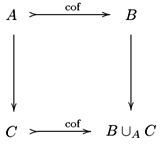 | ||
In mathematics a Waldhausen category (after Friedhelm Waldhausen) is a category C with a zero object equipped with cofibrations co(C) and weak equivalences we(C), both containing all isomorphisms, both compatible with pushout, and co(C) containing the unique morphisms
from the zero-object to any object A.
To be more precise about the pushouts, we require when
is a cofibration and
is any map, that we have a push-out
where the map
is a cofibration:
A category C is equipped with bifibrations if it has cofibrations and its opposite category COP has so also. In that case, we denote the fibrations of COP by quot(C). In that case, C is a biWaldhausen category if C has bifibrations and weak equivalences such that both (C, co(C), we) and (COP, quot(C), weOP) are Waldhausen categories.
As examples one may think of exact categories, where the cofibrations are the admissible monomorphisms. Another example is the full subcategory of cofibrant objects in a pointed model categories, that is, the full subcategory consisting of those objects
Waldhausen and biWaldhausen categories are linked with algebraic K-theory. There, many interesting categories are complicial biWaldhausen categories. For example: The category
